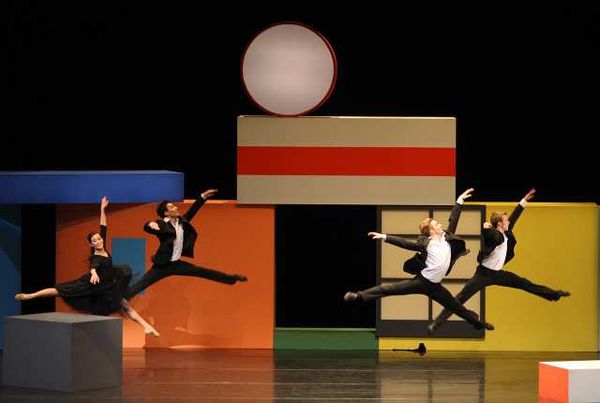[This article first ran in the L.A. Times.]
Touring with contemporary, soft-slippered ballets, Ballet du Grand Théâtre de Genève made its West Coast debut at the Dorothy Chandler Pavilion on Friday with a trio of eye-catching works set to canonical ballet music choreographed by Benjamin Millepied, now known widely for his work in “Black Swan.”
Heretofore unseen in the U.S., “Amoveo,” “La Spectre de la Rose,” and “Les Sylphides” gave weekend concertgoers a taste of the bright designs, group dynamics and knotty, weighted movement lexicon that stand to be a fixed point in Los Angeles’ dance future. (Millepied has plans for a new “L.A Dance Project” arts collective in alliance with the Music Center next season.) Stimulated by humor, sexuality and surprise, these dances never sagged. But they had some off-flavors.
In “Amoveo” (2006), set to four excerpts from Philip Glass’ “Einstein on the Beach,” relationships moved from delineation to unreadability in seconds, while Paul Cox’s Op Art scrim filled with two slow-moving lines of color that multiplied into a dizzying crosshatch. Tangled, exhaustive partnerings echoed the ceasless looping organ. Finishes were casual, even ugly.
Weight was signaled obsessively — women over-responded to gravity, men ricocheted in response to nothing much, neither could assume closed-foot positions. Thus when a duo (Madeline Wong, Nathanaël Marie) managed to fulfill an airborne balance, it took on climactic proportions. Likewise when men launched into clear buoyant jumps that ended with neatly tucked feet, one’s heart soared (this, plus the Santo Loquasto-style costumes, was pure Paul Taylor). But why didn’t the droopy women ever get a similarly clear, independent moment in “Amoveo”?
The woman (Sarawanee Tanatanit) in “Le Spectre de la Rose” (2011), set to Carl Maria Von Weber’s “Invitation to the Dance,” began folded over, asleep on her feet, while a fat moon glowed on Cox’s handsome bedroom set. She didn’t rouse when three memorable masked men (Joseph Aitken, Pierre-Antoine Brunet, Vladimir Ippolitov) burst through the window and launched into bravura side-split leaps like a treasured “Land of Crime” divertissement.
The delightful ending set her free, but why was she man-handled while sleeping for two-thirds of the piece? There are many ways to convey a dreamer.
Men and woman both acted ignobly in Millepied’s all-too-human “Les Sylphides,” with another clean, peppy set and updated Romantic bell-shaped tutus (sadly leadening sans pointe shoes) by Cox. Again featuring women with low centers of gravity and emphatic torsos (Daniela Zaghini shone) and vertical men who broke through their inertia like jumping dolphins, the piece seemed hurriedly assembled and under-rehearsed.
If only the entire piece were as visionary, rhythmic and crafted as the quick-framed Prelude section, which began and ended with a woman’s (Yu Otagaki) outstretched reach toward a translucent lightbulb.
